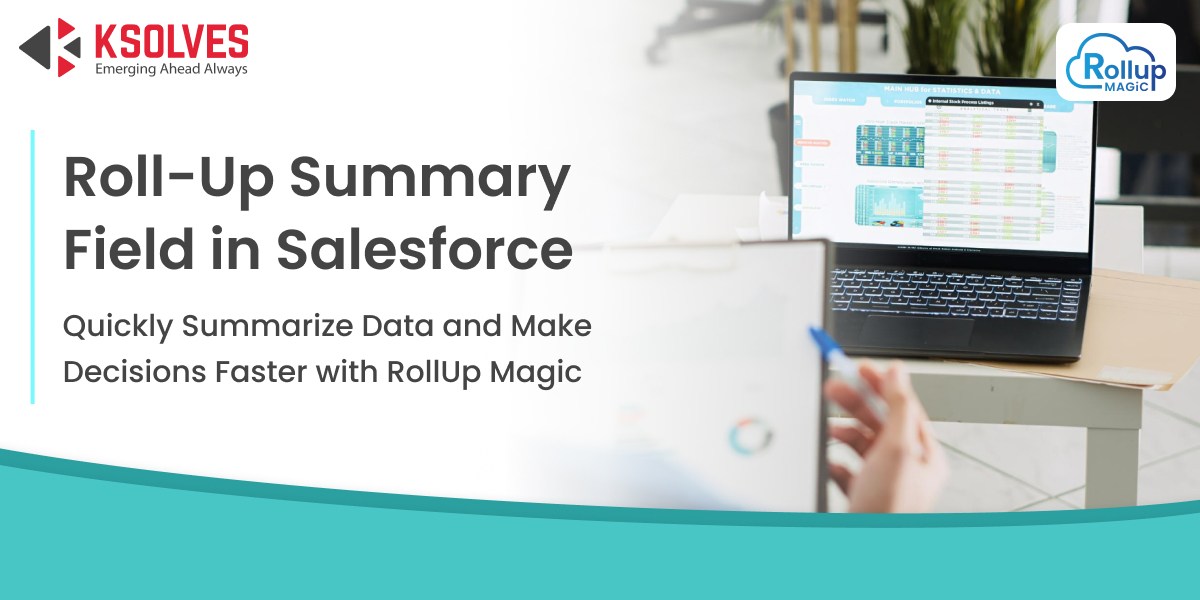A Guide to Roll-Up Summary Field in Salesforce: Types, Use Cases, Benefits, & Limitations
RollupMagic
5 MIN READ
February 21, 2025
![]()

With more than 150,000 customers worldwide, Salesforce has gained immense popularity among businesses of all sizes, which makes it a de facto CRM. However, managing and analyzing Salesforce data can be daunting & complicated, especially when it is spread across multiple objects. This is where the role of a roll-up summary field comes into the picture.
Imagine you want to track the total revenue generated in a specific month or the total number of customer cases opened. Manually aggregating this data stored across different Salesforce objects is time-consuming, error-prone, and cumbersome. Salesforce roll-up summary fields simplify aggregating data across objects to provide you with the required results.
Let’s dive into the details of the roll-up summary field in Salesforce in this blog.
What is a Roll-Up Summary in Salesforce?
A roll-up summary in Salesforce serves as a useful tool to display a value on the master (parent) record based on the computations performed on the detail (child) records. However, these detail records should be directly associated with the master record through a master-detail relationship.
Rollup summary fields eliminate the need for writing custom Apex triggers for data aggregation, reducing the dependency on technical expertise.
Understanding a Master-Detail Relationship
A master-detail relationship is a tightly coupled connection between two Salesforce objects, where one object is parent (master) and the other is child (detail). The child object inherits all security settings from the parent object.
For instance, if you have the right to read, edit, or delete data stored in the parent object, you can perform the same operations on associated child objects.
Key properties of the master-detail relationship include:
- The parent object completely owns the child object.
- The child object cannot exist without the parent object.
Let us understand this relationship with an example.
Consider “Invoice” and “Invoice Line Items” as two Salesforce objects. An invoice can have multiple line items. Here, the master record is “Invoice” and the detail record is “Invoice Line Items”. If you delete the invoice (master record), all invoice line items (detail records) are deleted automatically.
How does Roll-Up Summary Work?
Let’s take into account the above master and detail records – Invoice and Invoice Line Items. Now consider that you need to calculate the total amount of the Invoice Line Items.
You can use the SUM roll-up summary on the Invoice object that calculates the total value of the invoice line items associated with that invoice. Simply create a field Total Invoice Amount on the Invoice object. Leveraging the SUM roll-up automatically calculates the total values from the related Invoice Line Items. Additionally, every time when a new invoice line item is added, the roll-up updates the Total Invoice Amount field dynamically.
Types of Roll-Up Summary Fields in Salesforce
Salesforce supports four types of roll-up summary fields as follows:
- SUM Roll-Up Summary Field
The SUM roll-up summary field calculates the total sum of the selected numeric field from all the related child entries. It is possible to use this function only on the number, currency, and percent fields.
Example: In the above example, the SUM roll-up summary field provided the total amount of line items associated with a particular invoice.
- MAX Roll-Up Summary Field
The MAX roll-up summary field displays the highest or maximum value from the selected numeric, date, or time field among the detail records. This function supports number, currency, percent, date, and date/time fields.
Example: A single sales opportunity may have multiple quotes at different prices. Here, the master record is Sales Opportunity and the detail records are Quotes. The MAX roll-up summary on Sales Opportunity displays the related Quote with the highest price.
- MIN Roll-Up Summary Field
The MIN roll-up summary field displays the lowest or minimum value from the selected numeric, date, or time field among the detail records. This function supports number, currency, percent, date, and date/time fields.
Example: A single building may have multiple properties with different rental prices. Here, the master record is Building and child records are Properties. The MIN roll-up summary on Building provides the associated Property with the lowest rental price.
- COUNT Roll-Up Summary Field
The COUNT roll-up summary field displays the total number of detail records associated with the master record.
Example: A single customer may have multiple orders. Here, the master record is Customer, and the detail records are Orders. The COUNT roll-up summary field on Customer provides the total number of related Orders.
Use Cases of RollUp Summary Fields in Salesforce
Let’s now understand some scenarios where businesses can use roll-up summary fields in their operations.
1. Sales & Revenue Tracking
Sales teams often need to track the revenue generated by all opportunities for an account and deal progress. Here’s how roll-up summaries can help:
- Total Revenue per Account: SUM roll-up calculates the sum of the total value of closed won opportunities under an account, displaying the total revenue.
- Number of Deals per Account: COUNT roll-up displays the total number of opportunities linked to a particular account. This helps sales teams to determine the number of deals in a pipeline for a specific customer.
2. Inventory & Order Management
E-commerce businesses need to stay on top of inventory levels and orders. This helps them prevent overstock or stockout conditions. Roll-up summaries can provide them with appropriate insights into stock levels and order information.
- Total Order Value per Customer: SUM roll-up calculates the total amount of sales orders associated with a specific customer.
- Number of Orders per Customer: COUNT roll-up displays the total number of orders placed by a particular customer.
- Total Quantity of a Product Sold: Count roll-up provides you with the total number of product units sold.
3. Customer Support Insights
Customer service teams often strive to improve customer experience and maximize satisfaction with faster resolution. They can use roll-up summary fields to track case volumes and response times.
- Number of Open Cases per Account: COUNT roll-up summary to determine the number of open cases (unresolved) cases per account and product.
- Track the First Response Time: MIN roll-up to identify the minimum time required to respond to open cases.
4. Finance and Accounting
The two common use cases of roll-up summary fields for finance teams are payment tracking and financial reporting.
- Total Revenue per Financial Quarter: SUM roll-up computes the total revenue from all closed-won opportunities within a specific quarter.
- Number of Overdue Invoices: COUNT roll-up summary gives the total number of overdue invoices for an account.
- Pending Payment Amount: SUM roll-up aggregates the total unpaid invoice amount for a customer to track the outstanding balance.
5. Marketing & Lead Tracking
Marketing teams often need to track campaign performance and lead qualification, They can do this with roll-up summaries in Salesforce, as follows:
- Number of Leads Converted from a Campaign: COUNT roll-up gives the total number of leads converted from a specific campaign.
- Total Ad Spend on a Campaign: SUM roll-up computes the total amount spent on ads for a campaign.
- Number of Interactions per Lead: COUNT roll-up provides the total number of calls, messages, and meetings per lead.
Benefits of Using Roll-Up Summaries in Salesforce
Roll-up summary fields in Salesforce provide an efficient way to summarize related records in a master-detail relationship. Businesses use them to gain real-time insights, reduce manual effort, and enhance decision-making. Here are the key benefits:
- Automates Data Aggregation
Eliminates the need for manual calculations by automatically summarizing data from child records to the parent record.
- Provides Real-Time Business Insights
Ensures that summarized data is always up to date whenever a related record is created, updated, or deleted.
- Enhances Decision-Making
Enables managers and executives to make quick, data-driven decisions by providing key metrics at a glance.
- Reduces Human Error & Improves Accuracy
Eliminates the risk of manual miscalculations by automatically pulling data from related records.
- Saves Time & Increases Efficiency
Reduces the need for custom formulas, reports, or Apex triggers, making it easier to manage data.
Limitations of Standard Roll-Up Summaries
While Roll-Up Summary Fields are powerful tools for summarizing related records in Salesforce, they come with certain limitations that users should be aware of:
- Only Available in Master-Detail Relationships
Roll-up summary fields can only be created in master-detail relationships. They are not available in Lookup relationships, limiting their use in scenarios where there’s no strict parent-child relationship between objects.
- Cannot Be Used on Lookup Relationships
If you need to summarize data from records in a lookup relationship, you’ll need to explore alternative options, as roll-up summary fields won’t work in this context.
- No Support for Average Function
Standard Salesforce roll-up summary fields do not support the Average function. They only support 4 major functions – SUM, MIN, MAX, and COUNT.
- One-to-Many Relationships Only
Roll-up summary fields are designed for one-to-many relationships, meaning they cannot summarize data from a many-to-many relationship (such as via a junction object).
- Manual Calculation Updates
Although roll-up summary fields automatically update in response to changes in related records, complex calculations, such as filtering on specific criteria or performing custom aggregations, cannot be achieved without using other methods like Apex or Flows.
Utilizing RollUp Magic to Overcome Limitations
RollUp Magic offers a more flexible solution by overcoming these limitations and enabling users to perform advanced roll-up operations in Salesforce.
Here’s how it can help:
- Works with Lookup Relationships
Unlike standard roll-up summary fields, RollUp Magic can roll up data across lookup relationships. This opens up new possibilities for aggregating data even when a strict parent-child relationship doesn’t exist.
- Custom Parent/Child Filters
RollUp Magic empowers you to create highly customized rollups by applying specific parent/child filters. This feature ensures that only the records you want are included in the rollup, making your data management more precise.
- Supports the Average Function
In addition to standard roll-up functions, RollUp Magic supports the average function, allowing you to calculate the average value of a field across related records. This is particularly useful for scenarios where you need to track averages, such as average sales, performance scores, or customer satisfaction metrics.
- Schedule Rollups
RollUp Magic takes automation to the next level with the ability to schedule rollups. You can define when your rollups should run – whether it’s daily, weekly, or monthly – ensuring your data is always fresh and up-to-date. No more manual intervention or worrying about outdated reports. Just set it and forget it.
- No Custom Code
With RollUp Magic, there’s no need for custom code or complicated Salesforce development. Its intuitive interface allows you to create and manage rollups with ease. Simply select your criteria, and the tool does the rest. Whether you’re a Salesforce admin or a business user, RollUp Magic makes it easy to manage your data without the overhead of custom code or development expertise.
Conclusion
While roll-up summary fields in Salesforce are an excellent tool for aggregating data in master-detail relationships, they come with inherent limitations that can restrict their use in more complex scenarios. RollUp Magic steps in to fill these gaps, offering enhanced functionality for lookup relationships and advanced filtering.
With RollUp Magic, Salesforce users can go beyond the standard roll-up summary’s constraints and take full advantage of automated data aggregation — all while avoiding the need for custom coding.
Unlock new levels of data management, accuracy, and efficiency for your business with RollUp Magic! Book your demo today!
![]()





Author
Share with